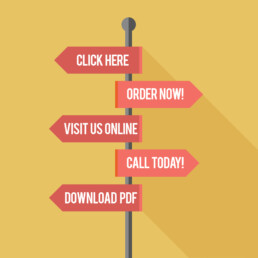Following directions toward conversion
In marketing communication, a call-to-action (CTA) is a response-request statement included to move the target audience in a desired direction. A good call-to-action lets the reader or listener know there is more information available, and how to obtain that value. Typically appearing at the close of a marketing message, CTAs should be used in everything from direct mail and brochures to email and websites to help move leads through the marketing funnel toward conversion.
A call-to-action directs traffic
CTAs can turn your individual marketing communication efforts into a powerful storytelling network. You can use a CTA to send your audience from one article on your website to a related story, promote a special offer or bridge the gap between print and digital marketing. Organically linking several messages helps your audience understand how to engage with your brand.
A call-to-action helps to build an audience
You can use a CTA to request contact information in exchange for valuable content, like a downloadable white paper or a subscription to a newsletter. Combined with progressive profiling, this tactic allows you to fill in contact information gaps for existing leads, too. Building a permission-based audience in this manner helps create an ideal platform for targeted communication and engagement.
A great marketing campaign can be cut short if the call-to-action isn’t effectively executed. Communicating your company’s value and benefits is meaningless if your audience doesn’t know how to contact you or if they’re delivered to a dead end. Leads will be confused and frustrated when sent to a website homepage with no additional direction or received by a salesperson who is unaware of a promotion.
Creating an effective call-to-action
The actual function of a CTA is pretty straightforward, but using one strategically within a campaign clearly takes a little bit of planning. Now that your audience has completed this message, where would you want them to go next? What is the goal of this message and where does it fall in the customer journey? Is the next marketing component prepared to receive your audience?

Your call to action strategy should check these five boxes:
1.) Be obvious
Make sure the next step is clear; don’t tuck your message away in a corner or hide your button in a busy area. Give the CTA room to breath in the design and use contrast to call attention. Use imperatives to communicate the desired action.
2.) Be concise without being vague
“Click here” and “Call now” are to the point, but they’re not very compelling messages. Make sure to describe what will happen next using language that removes roadblocks. Address a specific pain point or solution mentioned in the text that accompanies the CTA.
3.) Stress the benefit
Reiterate what your audience will receive, how they will receive it, how they can use it and how it will help them. Give your audience a reason to continue the conversation.
4.) Prepare for landing
If you’re sending your audience to your website, it is preferable to have a landing page prepared that is in line with the campaign. If that is not possible, adding an icon to the homepage or a campaign-specific path to the URL can help with navigation. Make sure the receiving page uses the same language as the CTA for the sake of continuity. Be sure your sales team understands the call-to-action and the promise that is communicated.
5.) Track for success!
It’s essential to determine a key performance indicator (KPI) to track your call-to-action flow through. If your CTA requests the reader to call for more information, monitor the call increase to the listed number. If you’re directing your audience to a website or a different page, keep an eye on your site traffic. If you’re offering a downloadable premium, watch the number of downloads. This measuring practice will allow you to make adjustments as necessary and learn best practices for future marketing outreach.
